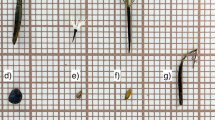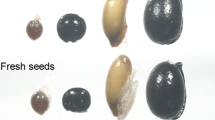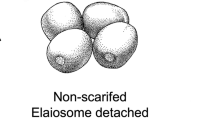Euphorbia characias is a Mediterranean spurge with a diplochorous dispersal system: after a ballistic dispersal that scatters the seeds, some ant species find and retrieve the seeds to their nest (myrmecochorous dispersal). The seed dispersal curve generated by ants in an abandoned field was described and partitioned according to ant size and to the distance to nest entrance from where seeds fell after ballistic dispersal. Both variables (ant size, distance to nest) affected dispersal distance. The seed dispersal curve showed a peak at short distance (median = 1 m) and a tail extending to 9.4 m. The peak and the tail are explained differently. Short distances are usually generated by small ants (Pheidole pallidula and Tapinoma nigerrimum; 0.56 ± 0.41 m [n = 48]) both from the nearest or farther nest entrances. The tail of the curve is generated disproportionately by big ants (Aphaenogaster senilis and Messor barbarus; 2.09 ± 1.71 m [n = 61]) from farther nests. Seeds have a much greater probability (P = 0.734) of being transported to nests which are not the nearest. This effect is largely due to transportation by big ants.
Similar content being viewed by others
References
Acosta F. J., López F., Serrano J.M. (1995) Dispersed versus central place foraging: inter- and intracolonial competition in the strategy of trunk trail arrangement of a harvester ant. American Naturalist 145: 389–411.
Andersen A. (1988) Dispersal distance as a benefit of myrmecochory. Oecologia 75: 507–511.
Auld T. (1986). Population dynamics of the shrub Acacia suaveolens (Sm.) Wild.: dispersal and the dynamics of the soil seed bank. Australian Journal of Ecology 11: 235–254.
Bolós O. (1962) El paisaje vegetal barcelonés. Universidad de Barcelona, Barcelona.
Bullock S. H. (1989) Life history and seed dispersal of the short-lived chaparral shrub Dendromecon rigida(Papaveraceae). American Journal of Botany 76: 1506–1517.
Chambers J. C. & MacMahon J. A. (1994) A day in the life of a seed: Movements and fates of seeds and their implications for natural and managed systems. Annual Review of Ecology and Systematics 25: 263–292.
LARKP. J. & EVANS F. C. (1954) Distance to nearest neighbor as a measure of spatial relationships in populations. Ecology35: 445–453.
CSS: statistica (1991) Vol. II. Statsoft Inc.
Espadaler X. & Gómez C. (1996) Seed production, predation and dispersal in the Mediterranean myrmecochore Euphorbia characias (Euphorbiaceae). Ecography 19: 7–15.
Espadaler X. & Gómez C. (1997a) Falling or movement of seeds and the presence of an elaiosome: its effect on ant reaction (Hymenoptera, Formicidae) in a myrmecochorous species, Euphorbia characias (Euphorbiaceae). Sociobiology 30: 175–183.
Espadaler X. & Gómez C. (1997b) Soil surface searching and transport of Euphorbia characias L. seeds by ants. Acta Oecologica 18: 39–46.
Espadaler X., Gómez C., Suñer D. (1997c) Seed-robbing between ants intervenes in the myrmecochory of Euphorbia characias (Euphorbiaceae). Psyche 102: 19–25.
Gibson W. (1993) Selective advantages to hemi-parasitic annuals, genus Melampyrum, of a seed-dispersal mutualism involving ants: I. Favorable nest sites. Oikos 67: 334–344.
Gómez C. & Espadaler X. (1994) Curva de dispersión de semillas en Euphorbia characias L. y Euphorbia nicaeensis All. (Euphorbiaceae). Ecologia Mediterranea 20: 51–59.
Gómez C. & Espadaler X. (1997) Distancia, áreas de forrajeo y territorio en Aphaenogaster senilis Mayr. Miscellània Zoològica 19: 19–25.
Gómez C. & Espadaler X. (in press) Aphaenogaster senilis Mayr (Hymenoptera, Formicidae): a possible parasite in the myrmecochory of Euphorbia characias(Euphorbiaceae). Sociobiology 32.
Green D. (1983) The efficacy of dispersal in relation to safe site density. Oecologia 56: 356–358.
Heithaus E. R. (1981) Seed predation by rodents on three ant-dispersed plants. Ecology 62: 136–145.
Higashi S., Tsuyuzaki S., Ohara M., Ito F. (1989) Adaptative advantages of ant-dispersed seeds in the myrmecochorous plant Trillium tschonoskii (Liliaceae). Oikos 54: 389–394.
Hölldobler B. (1976) Recruitment behavior, home range orientation and territoriality in harvester ants,Pogonomyrmex. Behavioral Ecology Sociobiology 1: 3–44.
Horvitz C. C. & Beattie A. J. (1980) Ant dispersal of Calathea (Marantaceae) seeds by carnivorous ponerinaes (Formicidae) in a tropical rain forest. American Journal of Botany 67: 321–326.
Horvitz C. C. & Schemske D. W. (1994) Effects of dispersers, gaps, and predators on dormancy and seedling emergence in a tropical herb. Ecology 75: 1949–1958.
Hughes L. & Westoby M. (1992) Fate of seeds adapted for dispersal by ants in Australia –sclerophyll vegetation. Ecology 73: 1285–1299.
Le Corff J. & Horvitz C. C. (1995) Dispersal of seeds from chasmogamous and cleistogamous flowers in an ant-dispersed neotropical herb. Oikos 73: 59–64.
Levings S. C. & Traniello J. F. A. (1986) Intra and intercolony patterns of nest dispersion in the ant Lasius neoniger: correlations with territoriality and foraging ecology. Oecologia 69: 413–419.
Mesler M. R. & Lu K. L. (1983) Seed dispersal of Trillium ovatum (Liliaceae) in second-growth redwood forests. American Journal of Botany 70: 1460–1467.
Ohara M. & Higashi S. (1987) Interference of ground beetles with the dispersal by ants of seeds of Trillium species (Liliaceae). Journal of Ecology 75: 1091–1098.
Ohkawara K. & Higashi S. (1994) Relative importance of ballistic and ant dispersal in two diplochorous Viola species (Violaceae). Oecologia 100: 135–140.
Oöstermeijer J. G. B. (1989) Myrmecochory in Polygala vulgaris L., Luzula campestris(L.) D.C. and Viola curtisii Forster in a Dutch dune area. Oecologia 78: 302–311.
Pudlo R. J., Beattie A. J., Culver D. C. (1980) Population consequences of changes in an ant seed mutualism in Sanguinaria canadensis. Oecologia 46: 32–37.
Punttila P., Haila Y., Niemelä J., Pajunen T. (1994) Ant communities in fragments of old-growth taiga and managed surroundings. Annales Zoologici Fennici 31: 131–144.
Savolainen R. & Vepsäläinen K. (1988) A competition hierarchy among boreal ants: impact on resource partitioning and community structure. Oikos 51: 135–155.
SERNANDER R. (1906) Entwurf einer Monographic der europäischen Myrmekochoren. Kungliger Svenska Vetenskapsakademiens Handlingar41: 1–410.
Sinclair D. F. (1985) On tests of spatial randomness using mean nearest neighbour distance. Ecology 63: 1084–1085.
Slingsby P. & Bond W. J. (1985) The influence of ants on the dispersal distance and seedling recruitment of Leucospermum conocarpodendron (L.) Bueck␣(Proteaceae). South African Journal of Botany 51: 30–34.
Toft C. A. (1984) Resource shifts in bee flies (Bombylidae): interactions among species determine choice of resources. Oikos 43: 104–112.
Westoby M. & Rice B. (1981) A note on combining two methods of dispersal-for-distance. Australian Journal of Ecology 6: 189–192.
Westoby M., Rice B., Shelley J. M., Haigh D., Kohen J. L. (1982) Plants’ use of ants for dispersal at West Head, NSW. In: Ant–Plant Interactions in Australia. (ed. R. C. Buckley) pp. 75–87. Junk Press, The Hague.
Author information
Authors and Affiliations
Corresponding author
About this article
Cite this article
Gómez, C., Espadaler, X. Seed dispersal curve of a Mediterranean myrmecochore: Influence of ant size and the distance to nests. Ecol Res 13, 347–354 (1998). https://doi.org/10.1046/j.1440-1703.1998.00274.x
Received:
Accepted:
Issue Date:
DOI: https://doi.org/10.1046/j.1440-1703.1998.00274.x




